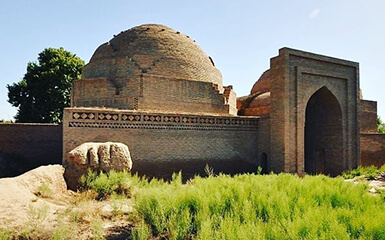Kok Gumbaz
Ajina Teppa
Ancient Panjakent
Anzob Tunnel
Beshkent Qala
Childukhtaron
Khazrati Shokh
Mug Teppa
Gharm Chashma
Hisor Historical
Haji Yaqub mosque
Hazrati-Bobo complex
Lake Iskanderkul
Kalai-Khumb
Karatag
Karon
Khishtin caravanserai
Khorog
Khulbuk
Lake Karakul
Abdullatif Sultan
Madrasai Kuhna
Abu Abdullah Rudaki
Khoja Mashhad
Khudoyor Valami
Makhmudi Azam
Mir Sayyid Ali Hamadani
Muhammed Bashoro
Sheikh Muslihiddin
Nurek Mountain Lake
Pamir
Sarazm
Sari-Khosor
Seven Lakes
Shirkent
Chiluchorchashma
Takht-i Sangin
Khoja Mashhad Mausoleum

The Khoja-Mashhad mausoleum, located in the village of Sayed (in the Kurgan-Tyube region) will amaze your imagination with the monumental form and virtuosity of brickwork. This is the only preserved wooden carved mausoleum in Central Asia.
Pre-Mongol XI-XII. It is one of the few madrasahs preserved until today. There are tombs, mosques and courtyard ivans (summer houses) from north to south around the right-angled courtyard. In the northern part of the territory, there are two large dome buildings, combined with the arch of Ivan. Built with burnt bricks (25x25x4 cm.), this structure is known as Khoja Mashhad Tomb or "Double Tomb". The other parts of the madrasah, which was built of mudbrick, were excavated by breaking. The total area of the madrasah is (68 x 48 m.). There are two round towers at the corner of the cupola building on the south façade of the monument. Some arched rooms (3.5-4 m.) surrounding the large courtyard, and ivans on the north, east and west facades of the courtyard were unearthed. The fragility of adobe bricks is one reason why many monuments in Tajikistan have been demolished. That is why those made of burnt brick are very valuable. The tomb section of the madrasah consists of two buildings (10.4 x 10.4 m.) and has a spherical dome. There are arched windows facing south on the foundations of the cupola and round openings in the keystones of the cupolas. The eastern mausoleum is older (IX-X centuries), a typical Central Asian central dome building of the early middle ages. The western and eastern walls are gated. The western mausoleum has some minor differences in details such as wall decorations.
Khoja-Mashhad is a real person known in the Islamic world; he arrived in Kabodian from the countries of the Middle East around the end of the ninth - beginning of the 10th centuries. He was a wealthy man who preached Islam. Most researchers believe that the madrasah was built with his money, and after his death, he was buried there. However, there are some legends about the mausoleum "arose" overnight wıth a miracle
Behind the mausoleums is a large rectangular courtyard surrounded by remnants of mud brick walls and demolished premises. Almost the entire territory of the courtyard is occupied by graves. The dome's earthen floors gape with dilapidated headstones.
There are many arguments about the purpose of these monuments. Since there are hujras along the perimeter of the courtyard, one might think that there was a madrasah next to the mausoleum and the mosque. Some scholars believe that Khoja Mashhad was a complex memorial complex with the functions of a khanaka. Previously, there was a hostel with hujras, a refectory, a living room, prayer rooms and meetings, ritual ablutions and a bath. In any case, it is obvious that the Khoja Mashhad architectural complex is a place of worship, a sacred burial is the most interesting architectural monument in Tajikistan.

